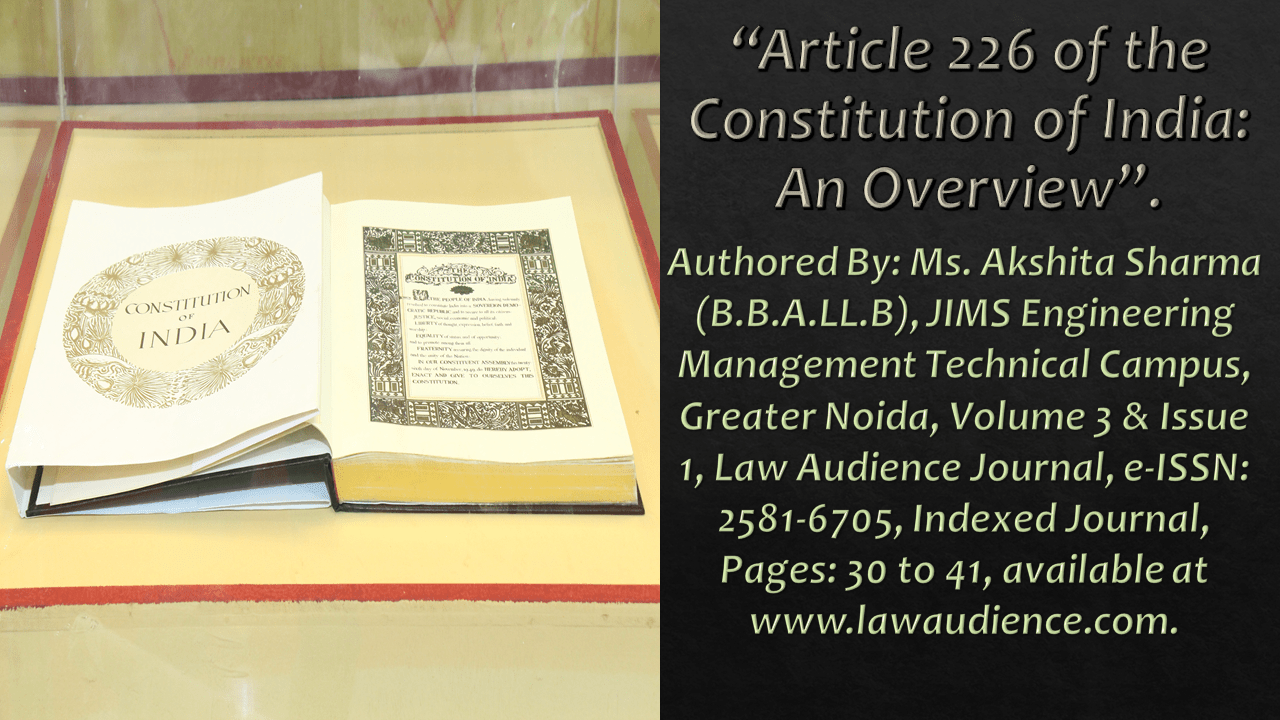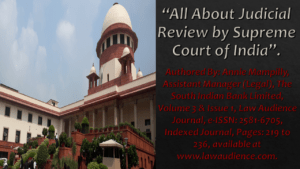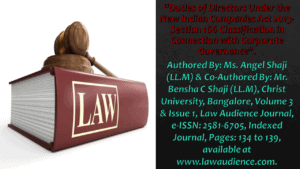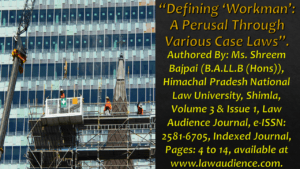Click here to download the full paper (PDF)
Authored By: Ms. Akshita Sharma (B.B.A.LL.B), JIMS Engineering Management Technical Campus, Greater Noida,
Click here for Copyright Policy.
ABSTRACT:
“Judicial review under Article 226 of the Constitution of India 1950 is directed, not contra the decision, but the decision-making procedure. Administrative decisions are in circumstances to judicial review under Article 226 of the Constitution of India 1950, only on basis of contrariness, patent illegality, unreasonable, want of power to take the conclusion and procedural irregularity. Other than on this basis administrative decisions cannot be intervened with, in the exercise of the considerable power of judicial review. A decision is destroyed by irrationality if the decision is so shocking, that it is in resistance of all logic; when no person acting justifiably could perhaps have taken the decision, having considered to the materials on record. A decision may occasionally be set aside and cancelled under Article 226 of the Constitution of India, 1950 on the basis of illegality. This is when there is an obvious error of law on the face of the decision, which goes to the origin of the decision and/or in other words an obvious error, but for which the decision would have been or else. Naturally, a patent illegality and/or error obvious on the face of the decision, which goes to the origin of the decision, may pervert the decision-making process.”
Keywords: Writ Petition, Article 226, Constitution of India.
I. INTRODUCTION:
The Constitution of India is the grundnorm of the land. It was drafted to study and understood by layperson and lawman similar, however, after the seven period from the day we got independence the frightened articles of Constitution of India become so hard that if today a layperson would surely be lost if he is to go by the bare text of Constitution and the cause is that there is a wide difference in the middle of the bare text and what is being come after politeness many judgments by Hon’ble Courts of law be it Supreme Court, Apex Court of law in India or be it a High Court. Now, world’s greatest democracy is stood big and doing great as it has been now and then held up by its judicial pillar where many have been martyred throughout this holy struggle. India has been under British rule for over two hundred years direct. Britishers though instituted formal courts of law in India but they did not permit many circumstances to judges to exercise as they codified the laws here. Hence, when we adopted Constitution in 1950 the courts of law were not aware enough to expedition far from the meaning of the words of laws in force. Nevertheless, after the crisis of 1975 judiciary began its change from judiciary of police state to that of a welfare state in genuine sense. From here now, courts of law begin to adopt determined interpretation, golden rule of explanation to the provisions of law in order to do entire justice.
I.I RESEARCH QUESTIONS:
- What is the role performed by the Courts for the protection of fundamental rights?
- How the Court elucidate the Articles of the Constitution for providing complete justice to the citizens?
I.II AIM AND OBJECTIVE:
Article 226 not only grants the power to issue direction, order or writs not impose fundamental rights but also for the imposition of other rights too. Article 226 authorizes High court to issue directions, orders or writs to any person, power, government, or the public officials. Article 226 also speaks about the interim order for writs and also provides the mechanism of how interim order will be thrown off by the High courts.
I.III RESEARCH METHODOLOGY:
The researcher has chosen a purely doctrinal procedure of legal research in doing the project. The researcher has used distinct tools of research such as books, journals, online resources, the books of Constitution of India and other obligatory tools as per the requirement.
The references of data are primary e.g., Constitution, Supreme Court’s judgments, also secondary e.g., articles, journals, books etc. The researcher has also chosen an analytical approach for explanation and drawing the conclusion. The researcher has used a constant mode of citation all over the course of this research paper.
II. JURISDICTION OF HIGH COURT UNDER ARTICLE 226 OF THE CONSTITUTION OF INDIA:
The elementary principle of the Common law and Indian law system is based on the popular maxim Ubi Jus Ibi Remedium which means that wherever there is right there is a remedy. In easy sense, there can’t be any wrong without a remedy. Article 226 which gives the authority to the High Courts of the all the States for the implementation of fundamental rights also the other constitutional rights.[1] This means that the authority of a High Court under Art. 226 is broader than the power of the Supreme Court under article 32 and the other thing is that if an administrative action does not influence a Fundamental Right, then it can be confronted only in the High Court under Article 226. The powers of the High Court under Article 226 are optional.
II.I WHO CAN APPLY?
The applicability of Article 226 relies on the capability of the person and whether such a happening is capable of being perceive. The actuality of legal rights must be the right of the petitioner and this acts on the ground on which the jurisdiction of this article is conduct into play. An aggrieved person may apply for an appeal if the person can show that the person has been contradicted or deprived his rights or load with legal burden. The chief test to decide whether a person is resentful is to check whether the order influences his concern detrimental.
In the case of Cooverjee vs. Excise Commissioner[2], it was held that where the behavior of the officers is not in accordance with the law or they act in surplus of their jurisdiction it would be open to a person who had provide at an auction to approach the High Court under Article 226 of the constitution.
Though, in another case of State of West Bengal vs. Union of India[3] the Calcutta High Court permits standing to the state of West Bengal to file a writ petition under Article 226 look for directions contra the Union of India.
The question is appearing whether the writ laid contra the private person or the company for the contravention of fundamental rights? In connection to Article 226 there is no difficulty, the High Court has power to issue writs also contra the private person or company.
II.II WHETHER ABSOLUTE PRIVATE RIGHTS CAN BE IMPOSED THROUGH ARTICLE 226?
M/S Ipjacket Technology India Pvt Ltd v. M.D. Uttar Pradesh Rajkiya Nirman Nigam Ltd[4],
The solution under Article 226 of the Constitution being a remarkable remedy, it is not planned to be used for the motive of declaring private rights of the parties. In the case of imposition of contractual rights and liabilities the usual remedy of registering a civil suit being obtainable to the aggrieved party, the Court may not exercise its entitlement writ jurisdiction to enforce such contractual obligations. The lawful position in this consideration is that where the rights which are to look for to be agitated are merely of a private character no mandamus can be asserted, and even if the reassurance is sought against the State or any of its instrumentality the pre-requisite for the issuance of a writ of mandamus is a public duty. In an argument based on a clear contractual relationship there being no public duty component, a mandamus would not lie. The actual remedy in such cases would be to file a civil suit for declaring damages, injunctions or specific performance or such suitable reliefs in a civil court. Pure contractual duty in the absence of any statutory perspective would not be lawful through a writ.
II.III LIBERALIZATION OF LOCUS STANDI:
Locus Standi of the candidate or petitioner is a sine qua non or condition precedent for the exercise of the authority or jurisdiction by the court.[5] Article 226 does not express the persons who are qualified to enforce the fundamental right by filing a writ petition before the Supreme Court or the High Court.[6] On the non-attendance of this, the court might apply the English certiorari idea of a “person aggrieved” and make universal rule, the person whose right is contravene has right to apply writs in front of the Supreme Court or High Court. Overruling the general notion that a stranger can’t move the writ, it has been held that an outsider is a person aggrieved and has locus standi to move a court for an accurate common with general public.[7] Now it is liberalized as much that the court contemplate a letter send to it complaining about the infringement of fundamental rights as a writ petition. This advanced strategy has been developed by the Supreme Court for providing easy obtain to justice to the inadequate section of the community and a strong tool in the hands of public lively individuals and social action groups, for tackling exploitation, unfairness and securing for under privileged sections of the society their social, economic allotment. This is examined as highly effective ammunition in the armory of law for arriving social justice to the ordinary man.[8]
II.IV DELAY AND LACHES:
The fundamental proposition for administration of justice is that the courts will help those who are observant about their rights and not whom which will sleep on their privileges. In Preeti Kushwah vs. State of MP[9], this petition under Article 226 of the Constitution has been filed look for the following reliefs;
- The petition may benevolent be allowed.
- Respondents are administered to grant the interest to the petitioner in conformity with the judgment of the Hon’ble Apex Court in the case Ram Naresh Rawat vs. Ashwini Ray and Ors[10].
- Any other assistance which the Hon’ble Court deems fit in the actuality and circumstances of the case.”
Delay or laches is one of the elements which are to be supported in mind by the High Court when they exercise their optional powers under Article 226 of the Constitution. In a suitable case the High Court may decline to invoke its exceptional powers if there is such carelessness or omission on the part of the candidate to assert his right as taken in co-occurrence with the lapse of time and other situation, causes prejudice to the opposing party. Even where fundamental right is included the matter is still inside the discretion of the Court as noted out in the case Durga Prashad vs. Chief Controller of Imports and Exports[11]. Naturally, the discretion has to be exercised legally and reasonably.
III. TYPES OF WRITS:
III.I HABEAS CORPUS:
The term ‘Habeas Corpus’ is a Latin term which exactly means ‘to have the body’. This writ is issued to release a person from unlawful detention. If a person is imprisoned illegally and contra his consent, he can file an application in the Supreme Court or the High Court.
The extent of this writ was expanded by the judiciary which was elucidated in various cases like Sheela Barse vs. State of Maharashtra[12], that the doctrine of locus standi is liberal in habeas corpus cases. This means that if an imprisoned person cannot plead for his relieve, his family, friends or any other person can file a request and approach either of the two courts for the similar. Therefore, this writ helps in securing the liberty and freedom of the citizens.
If the Court is pleased with the application given, it can issue the writ of Habeas Corpus. By way of the writ, the Court orders the existence of the person who had imprisoned another person, ask them to provide a valid ground for the detention and orders relieve of the detained person if it discovers that the detention is not legally reasonable and void.
The detention is illegal if:
- The due procedure established by law was not accompanied for detaining a person.
- Detention was not in conformity with the law.
The request of this writ can be better comprehended by looking at the case of T.V. Eachara Varier vs. Secretary to the Ministry of Home[13], generally known as the Rajan Case where a young boy, P Rajan was capture into police custody while he was studying in the college campus. The principle of the college enlightened the father of the child about his arrest. This was done in course of the period of national emergency and for months, the location of the boy was not told to his family. In this case, the Court noticed that P Rajan had been detained without any grounds and issued the writ of Habeas Corpus for presentation of Rajan before itself.
There are certain situations where the writ of Habeas Corpus cannot be called on. These involve:
- If the person is detained as an outcome of a sentence or order given in a legal proceeding.
- If the person is put into manual restraint under the law albeit the law is declared as an unconstitutional.
- If the detained person has so far been released.
- If the person who imprisoned another person does not come under the territorial jurisdiction of the Court in which the request has been filed.
- If the writ is filed during the emergency circumstances. Therefore, it must be understood that the writ of habeas corpus would be continue only for the infringement of fundamental rights granted in Articles 20and 21 of the Indian Constitution even during the emergency circumstances.
III.II MANDAMUS:
The Latin term ‘Mandamus’ means ‘we command’. The writ is issued in the structure of a command given by the judiciary which administers a constitutional, statutory or non-statutory body to execute a public duty which has been levy upon it by the law. It can also be issued by a superior court authoritative to an inferior court to execute its duties. This writ is also issued to stop the authority from doing a specific act, which it is not legally qualified to do. The writ of Mandamus cannot be issued contra a private individual who is not legally essential to perform the public duty.
The writ of mandamus is issued on the following basis:
- The petitioner has a lawful right.
- The lawful right of the petitioner has been violated.
- The lawful right has been violated because of the non-performance of a legally essential duty by a public authority or by a private individual who is performing under public authority.
- The petitioner has required the performance of the duty but the public authority has dismissed to perform it.
In the case of Bhopal Sugar Industries Ltd. vs. Income Tax Officer[14], the Income Tax Appellate Tribunal grants the respondent, an income tax officer definite direction for discovering the market value of sugarcane produce by the appellant in petitioner’s farms. Though, the respondent did not accompany these directions. The Supreme Court said that withholding to carry out an order given by a superior tribunal in the exercise of its appellate jurisdiction infringe the principles of justice and leads to disorder. Hence, the writ of Mandamus was issued administering the income tax officer to execute his duty in conformity with the order given by the Income Tax Appellate Tribunal.
III.III CERTIORARI:
The Latin phrase ‘Certiorari’ means ‘to certify’. It is issued in the structure of a command by a superior court commanding an inferior court or any other inferior quasi-judicial body to transfer the records of a proceeding waiting before it to the superior court. This is normally done in the following situations:
- When a superior court trusts that the Inferior Court does not have jurisdiction to conclude the matter.
- When the inferior courts infringe the principles of natural justice while concluding the matter.
- When the inferior court concludes on a matter obtained by fraud.
- When the lower court makes an incorrect decision because of an error of law which is evident on the face of the record. This means that if the inferior court makes a conclusion based on a clear ignore of a statutory provision, the superior court can issue the writ of certiorari. Thus, if the decision is made because of errors in facts, then the writ is not relevant. For example, if the High Court thinks that the District Court which heads a case did not have pecuniary jurisdiction to decide upon the incident, and yet the district court has taken up the incident, the High Court can issue this writ and cancel the district court’s order.
It must also be comprehended that the petition for Certiorari can only be made by the person who has been resentful. Hence, the doctrine of locus standi is very strict in the matters of certiorari. For this reason, it is examined as a proceeding in distinctive. The writ of certiorari is very significant because it acts as a corrective solution. For example, in the case of Rafiq Khan vs. State of U.P.[15] The appellants were sentenced under sections 352, 447 and 426 of IPC by the Panchayati Adalat. They approached the Sub-Divisional Magistrate for the identical and he modified the order given by the Panchayati Adalat. Allahabad high court said that the Sub-divisional Magistrate did not have a legal right to change the order and cancelled the modified order.
III.IV PROHIBITION:
The term ‘prohibition’ generally means ‘to forbid’. This writ is also called as ‘stay order’. It is issued by a superior court to stop an inferior court or a quasi-judicial body from ongoing its proceedings. It is issued in situations such as:
- When the inferior court or the quasi-judicial body does not have jurisdiction to hear the case.
- When the inferior court or quasi-judicial body infringe the principles of natural justice.
- When the inferior court or quasi-judicial body is not acting as per to the provisions of the law.
To comprehend this writ, one can mention to the case law East India Company Ltd. vs. the Collector of Customs[16]. In this case, the Supreme Court of India declared the writ of prohibition reject the respondent to begin the inquiry in an inferior tribunal on the basis that the proceedings were outside the tribunal’s jurisdiction.
III.V QUO WARRANTO:
The expression ‘Quo Warranto’ means “by what authority’. This writ prevents a person from acting in an office when he is not qualified to and has wrongfully seized the position. The basic fundamental motive of this writ is to make certain that an unlawful applicant does not take over a public office, as this can hurt the public and takes away occasion from those people who really deserve to take over that office. In the matters including the writ of quo warranto, anyone can file the petition, even if the person who is filing the petition has not been individually aggrieved. When the writ of Quo Warranto is issued, definite essentials need to be satisfied.
These involve:
- The office which has been incorrectly assumed is a public office, and not a private one.
- The public office has been generating either by a statutory provision or by the Constitution.
- The office is of an enduring nature and is not made for a provisional term.
- The person contra that the writ is to be issued is in ownership of the office.
- The person contra whom the writ is to be issued is one who has been barred from a public office yet continues to own it.
In the case P.L. Lakhan Pal vs. A.N. Ray[17], the engagement of Justice A.N. Ray as Chief Justice of India was challenged as of lack of seniority. Therefore, the court did not permit the writ of quo warranto because it would have been unless since the 3 other judges who were senior to him had vacate after his appointment and accordingly, he had gained superiority over all other residual judges in the Supreme Court.
IV. CONCLUSION:
With the similar power of enforcing fundamental rights, Article 226 has a much wider scope it can also be used to impose other legal rights conferred by the Constitution or any other law. Article 226 being a constitutional right gives optional power to the High Courts.
Moreover, it is the verdict of the Supreme Court under Article 32 which replaces the decision of High Courts under Article 226. While executing under Article 226, the High Court does not sit or act as an appellate authority over the orders or actions of the subordinate authority.
This jurisdiction is supervisory in character. One of the crucial reasons for this jurisdiction is to keep the government and tribunals inside bounds of their separate jurisdiction.
High Courts must make sure that while executing this function it does not contravene the well-recognized leap of its own jurisdiction.
Footnotes:
[1] MP Jain, Indian Constitutional Law, LexisNexis Butterworth’s Wadhwa, Nagpur, Sixth Edition, 2012, p.1431.
[2] AIR 1954 SC 120.
[3] AIR 1996 Cal.181.
[4] WRIT – C No. – 34346 of 2018.
[5] V.G. Ramachandran, Law of Writs, Eastern Book Company, Volume 1, Sixth Edition, 2002, p. 52.
[6] Cal. Gas Co. v. State of W.B. AIR 1962 SC 1044.
[7] Seethalakshmi Ammal v. State of T.N. AIR 1993 Mad 1 (FB).
[8] State of AP v. Parent of a student of Medical College AIR 1985 SC 910.
[9] WP No. 14001 of 2020.
[10] (2017) 3 SCC 436.
[11] (1969) 1 SCC 185.
[12] JT 1988 (3) 15.
[13] 1978 AIR 290, 1978 SCR (2) 209.
[14] 1977 AIR 1275, 1977 SCR (3) 578.
[15] AIR 1954 All 3.
[16] 1962 AIR 1893, 1963 SCR (3) 338.
[17] AIR 1975 Delhi 66, 11 (1975) DLT 1, ILR 1974 Delhi 725.
References:
- Constitution of India, 1950.
- MR Mallick, Writs Law and Practice, Eastern Law House, Kolkata, Second Edition, 2009.
- G. Ramachandran, Law of Writs, Eastern Book Company, Volume 1, Sixth Edition, 2002.
- MP Jain, Indian Constitutional Law, LexisNexis Butterworth’s Wadhwa, Nagpur, Sixth Edition, 2012.
- D. Basu, Constitutional Remedy and Writs, Kamal Law House, Kolkata, Third Edition, 2009.
- Justice P.S. Narayana, Law of Writs Asia Law House, Fifth Edition, 2008.
Cite this article as:
Ms. Akshita Sharma, Article 226 of the Constitution of India: An Overview, Vol.3 & Issue 1, Law Audience Journal, Pages 30 to 41 (25th May 2021), available at https://www.lawaudience.com/article-226-of-the-constitution-of-india-an-overview/.



